“What if an American comic book company were to ring me up (not that it was going to happen) and they offered me my first U.S. assignment, only it was the most obscure, uninteresting character I could imagine? So let’s, out of the blue, pick the most obscure American comics character I could think of and just see if I could reinterpret him and make him interesting.”
That’s Alan Moore describing himself, just before an American comic book company really did ring him up. It was DC editor Len Wein offering him a shot at Swamp Thing.

Weirdly, the “most obscure American comics character” Moore had practiced on was The Heap—the 1940s character Wein had knocked-off to create Swamp Thing in 1971.
The character type was oddly popular in the early 70s. Roy Thomas had been a Heap fan as a kid, and so when he got a staff writer job at Marvel, he created the Heap-like Glob for The Incredible Hulk #121 in 1969.
A year and a half later, Skywald comics resurrected the original Heap.
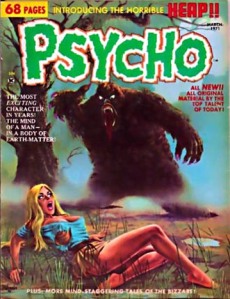
Thomas had told his pal, former Marvel employer and Skywald co-founder Sol Brodsky, it was a good band wagon to jump on since Marvel had its own Heap knock-off, Man-Thing. Stan Lee dreamt up that name, but apparently the Glob was all the regurgitated Heap that Thomas could swallow, so he handed the assignment to scripter Gerry Conway. Gray Morrow’s drawings even include a visual homage to the Heap’s vine-like nose in Savage Tales #1 (May 1971).
Thomas tossed the next Man-Thing assignment to Len Wein and Neal Adams who worked up a second episode, but Marvel cancelled Savage Tales after the first issue. Wein also freelanced at DC where he created Swamp Thing with artist Bernie Wrightson for House of Secrets #92 (June–July 1971). It took another year, but the Wein-Adams Man-Thing eventually surfaced in Astonishing Tales #12 (June 1972), just a few months before Wein and Wrightson updated their House of Secrets Swamp Thing for DC’s Swamp Thing #1 (October–November 1972).
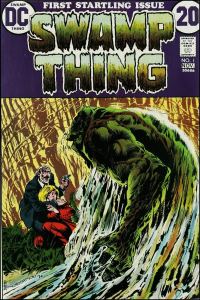
That’s a murky swamp of overlapping characters and creators to sift through. Worse, Wein and Conway were sharing an apartment at the time, and yet Wein swore Swamp Thing had nothing to do with Man-Thing—even though Man-Thing’s premiere is dated a month before Swamp Thing’s.
Thomas’s timetable doesn’t add up either: Skywald’s Heap premiered in Psycho #2 March 1971, three months before Man-Thing in Savage Tales #1. Add in the unknowable differences in production time, and the quagmire keeps deepening.
Neither Marvel nor DC tried to sue the other for copyright infringement, since both their characters were infringing on the Heap that Harry Stein and Mort Leav created for Hillman Periodicals’ Air Fighters Comics #3 in 1942. But Stein and Leav don’t get original credit either, since the Heap looks a lot like Theodore Sturgeon’s short story “It,” published two years earlier in Street and Smith’s Unknown.
Wein says he conceived Swamp Thing in December 1970, but
“Why I decided to make the protagonist some sort of swamp monster . . . I can no longer recall. . . . Coincidentally, Joe [Orlando, then-editor of THE HOUSE OF MYSTERY and THE HOUSE OF SECRETS] had been thinking of doing a story along the lines of Theodore Sturgeon’s classic fantasy tale ‘It’ . . . a story I had actually never read.”
And the swamp goes full circle when Roy Thomas scripted Marvel’s “It” adaptation for Supernatural Thrillers #1 (December 1972).

Sturgeon was invited to the 1975 San Diego Comic Convention so Ray Bradbury could hand him a Golden Ink Pot award. “I learned,” wrote Sturgeon, “for the very first time that my story ‘It’ is seminal; that it is the great granddaddy of The Swamp Thing, The Hulk, The Man Thing, and I don’t know how many celebrated graphics.”
The comic book swamp, however, was already draining, since Man-Thing was cancelled in 1975, and Swamp Thing the year after. It’s hard to explain the initial rise, though it probably has something to do with the 1971 change in the Comics Code:
“Vampires, ghouls and werewolves shall be permitted to be used when handled in the classic tradition such as Frankenstein, Dracula, and other high calibre literary works written by Edgar Allen Poe, Saki, Conan Doyle and other respected authors whose works are read in schools around the world.”
The Heap, after all, is a reanimated corpse. Though the cause of that reanimation is as murky as Swamp Thing’s creative origins. Is “the unearthly transformation” because World War I German pilot Baron Emmelmann’s “will to live” is such a “powerful force” that it merges his body with the slime and vegetation of the Polish swamp where his plane crashed, causing him to rise two decades later as “a fantastic heap that is neither man nor animal”? If so, why does the Heap “die” two issues later, only to be reanimated by a nefarious zoologist’s “serum”? And what does that mysterious serum have to do with “Ceres, Goddess of Soil,” who in 1947 is retconned (by an uncredited writer) into the origin, raising the dead pilot as an agent of peace in defiance of the god Ares?
Alan Moore did an even deeper retcon to Swamp Thing. Instead of a man transformed into a plant, the 1984 Swamp Thing is a plant transformed into a man.
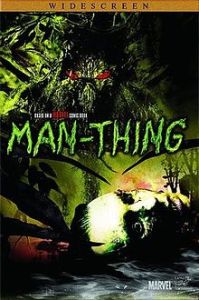
The 2005 Man-Thing movie (it apparently was intended to be theatrical release before demoted to the Syfy channel) goes for supernatural agency, though the Lee-Thomas-Conway-Morrow original was pure scifi: the inventor of a super-soldier serum injects himself and crashes his car into a swamp to keep the serum from the bad guys. The “formula”—updating Captain America’s premise for the Vietnam-era—is apparently napalm-based (a newspaper headline reads “NAPALM BOMB” as the inventor laments: “It’s bad enough the chemical will be used for more killing”), and so Man-Thing’s touch burns. Or it did until the second episode, when Wein decided it only burns those who feel fear because . . . that’s how napalm works? Steve Gerber ran with that non-scifi premise, mixing more supernatural agency into his revised swamp, which, it turns out, is really a doorway to multiple dimensions.
Although Man-Thing hasn’t been lying completely dormant for the last few decades, I’d say he’s still a descent contender for the current “most obscure, uninteresting comic book character” category. Or at least a mindless, shuffling heap of muck that reflexively burns people who are afraid isn’t a superhero high on Marvel Entertainment’s film and TV project list. Like Thomas for the Heap though, I have a squishy spot in my heart for him. So let me take on Alan Moore’s thought experiment, and see if I can “reinterpret him and make him interesting.” Or maybe the problem is Man-Thing is already too interesting? So my assignment is to cover his range of weirdness while sticking to a single, scifi-only premise.
I’m placing my swamp near New Orleans and staffing it with weapon designers. Instead of napalm and super-soldiers, it’s a burning black plasma that swirls and geysers when in contact with a remote control beacon, incinerating everything else it touches. But to be practical in the field, you’d need a live soldier to operate it. So the new design is a hazmat body suit with direct neural interface. The head gear includes two large red “eyes” and tubes down the nose and sides. Things are going great until the suit-tester starts getting nervous. As his vitals rise, the plasma hits new levels of heat and mobility. It starts burning through the suit, and before they can shut it down, it incinerates him, leaving only a blackened skeleton and gas mask. But since the plasma is encoded with the last neural input, it’s now moving on its own, splashing and lurching around the complex with its puppet of a charred corpse. When it breaks outside, it vanishes into the swamp, where the plasma merges with the muck and bonds around the skeleton. What emerges isn’t sentient. It’s not even alive. It just roams randomly or sits dormant until its eyes glow red with internal heat when it senses human fear—which it then extinguishes with its burning touch.
The original Conway script includes a scantily-clad female spy who betrays the inventor and then later gets her face burnt off by Man-Thing—so let’s please avoid that double dose of misogyny. Maybe the inventor is the woman this time, and the guy testing the suit is the spy who’s seduced her to steal the tech. His vitals spike because she’s about to find him out—so it’s not just fear but his guilt too. To his own surprise, he really does love her, and it’s only his bursting into flame that prevents the discovery of his betrayal, giving his transformation a redemptive edge. Turning into a monster stops him from being a monster. And I’m betting at the end she’s the only one who can face him without fear, an act of forgiveness that also allows the plasma to finally shut down and Man-Thing to collapse into a puddle of mud and bones.
Okay, so maybe not the light PG-13 tone of the current Marvel movie universe, but what do you expect from a mindless, fear-burning swamp beast? I suggest Marvel use the character for a multi-episode subplot during season three of Agents of S.H.I.E.L.D, not unlike how they used Deathlok (another early 70s super-soldier monstrosity) in season one.
Now let’s see if anyone rings me up.
(Meanwhile, instead of sitting by his own phone, Swamp Thing is headed to Reykjavik, Iceland, for the International Popular Culture Association Conference at the end of July. Nathaniel Goldberg, a colleague from the Washington and Lee University Philosophy department, and I are presenting our paper, “Donald Davidson and the Mind of Swamp Thing.”)
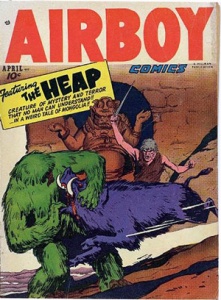

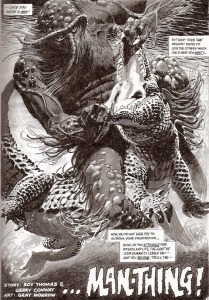
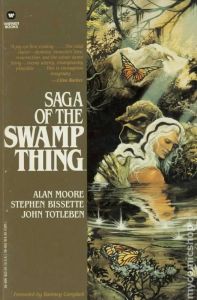

Quick precis of your paper, Chris?
A few things.
First, copyright renewal for the 1942 Air Fighters comic would have to have been filed in 1970 or 1971. No renewal was filed, so The Heap story there would have entered the public domain around the time Man-Thing and Swamp Thing made their debuts. The PD status is probably why Skywald was able to publish their own version of The Heap.
If Len Wein first conceived the Swamp Thing story in December 1970, it may have been after the first Man-Thing story was published. Per Marvel’s filing with the Copyright Office, Savage Tales #1 went on sale on December 22, 1970.
Incidentally, the filing for House of Secrets #92 says it went on sale on April 1, 1971.
For the record, GIANT SIZE MAN-THING.
Thank you.
Interestingly though, Roy Thomas’ Glob premiered in 1969, before the Heap was public domain. The rise in the character also parallels the late 60s envirnomental movement and the creation of Earth Day, which may or may not have contributed.
As far as our Iceland paper: the relationship between Wein’s ST (a man transformed into a plant) and Moore’s ST (a plant that thinks it’s a man) oddly parallels Donald Davidson’s thought experiment in which a dead tree is transformed into an exact replica of himself, aka The Swampman. In the thought experiment, Davidson is killed at the same moment, and The Swampman, believing itself to be Donaldson, assumes his life. Which is roughly what Moore did with ST–and he did so a couple of years before Davidson thought up his thought experiment. We can find no evidence of direct influence, but we have fun tracing the philosopnhical implications regarding whether either character can, according to Donaldson’s definitions, be said to have thoughts.
Well, if the character isn’t called The Heap, and the Hulk story isn’t a more or less exact copy of a protected Heap story, it’s hard to make the case for copyright infringement. The infringement disputes over comic-book characters are generally over trademark violation. Hillman quit publishing The Heap stories around 1953, and the company went out of business altogether in 1961, so it’s a safe bet the trademark was long dead.
As far as Swamp Thing and Man-Thing are concerned, do we know for sure there wasn’t a behind-the-scenes settlement between Marvel and DC? Marvel would seem to have DC over a barrel on this, particularly given that once Swamp Thing became a continuing character, he was even closer to Man-Thing than what was in the House of Secrets story.
Great work as always, Chris.
As a id both Man-Thing and Swamp Thing freaked me out. They may seem boring and interesting to our sensibilities (at least until Moore came along), but as a kid in the 70s that shit was wild.
Robert: we can’t know for sure, but there’s no hint of a secret settlement in the many interviews. Just after Nathaniel and I started this project, COMICBOOK CREATOR put out a “Swampman” issue that’s pretty exhaustive.
Osvaldo: YES, definitely some freaky shit!
Was anyone at the executive level of the companies asked about it? Stan Lee, Carmine Infantino, Paul Levitz? Unless there were editorial restrictions, there wouldn’t be any reason for the editorial or creative personnel to know about it. Marvel in particular back then kept the editors out of the loop when it came to business and legal matters.
On a personal note, I don’t put a lot of stock in TwoMorrows publications, including Comic Book Creator. I’ve learned to be very skeptical of interviews, particularly after seeing how Steve Gerber and many others have played the fan press for suckers. The non-interview material seems invariably about perpetuating the generational lore of comics fans from the 1970s. A fair amount of it is misleading if not outright wrong.
Fair point, Robert. The CBC interviews (some new, some old) include no one high on the business ladder, so who knows what was or wasn’t settled between companies.
Lee went the gooky, mushy swamp monster route four times during Marvel’s pre-superhero monster phase.
All were arguably mud monsters, colored brown, but at least one was colored a greenish brown, and one was a mud monster on the cover, but a one-eyed alien inside.
Taboo, the Thing from the Murky Swamp, appeared in “Strange Tales” #75 (June 1960) and #77 (October 1960).
Monstrom, a swampy mud guy on the cover, and a one-eyed alien inside, appeared in “Tales to Astonish” #11 (September 1960).
The Thing Called It, another muddy swamp monster, made an appearance in “Strange Tales” #82 (March 1961).
Finally, the last muddy swamp guy, Glob (who had the same name as Roy Thomas’ creature about a decade later), appeared in “Journey Into Mystery” #72.
And in addition to these sloshy swamp monsters, Lee and company unveiled several more swamp monsters during the same period — usually of alien origin — who had arms, legs, muscle tissue, and bones. Apparently in the Marvel Universe, aliens crash in swamps quite often.
So swamp thingy-type beasts — most probably inspired to some degree by the Heap (or the Creature From the Black Lagoon) — were regular Marvel fare long before Swamp Thing, Man-Thing, et al.
Thanks.
‘whether either character can, according to Donaldson’s definitions, be said to have thoughts.’
At least for the Wrightson/Wein Swamp Thing, the answer would be ‘yes’, right? Its thoughts have the appropriate kind of causal connection, however peculiar, to their external referents, right? Can’t exactly remember the details of Moore’s retcon, but I think the answer is ‘yes’ there too?
Yes, the 1971/1972 ST can think and use language meaningfully because he is still essentially the same person who learned the language–he has has that causal connection. But Moore’s ST has no history of learning language. It’s just a plant that mistakes itself for Alex, but it has no history of learning langauge, and so its words have no meaning. This gets more complicated when you apply both of Davidson’s contradictory definitions, which partially parallel the two STs, but that’s the gist. There’s a whole universe of issues involving identity (are you your memories?) that we tactically dodged in order to apply Davidson’s ideas to the characters. Happily, the J of Pop Culture already accepted it for publication.
hmmm, It’s been a long time since I read Moore or Davidson, but, IIRC, Davidson’s content externalism is a thesis about the meaning of thoughts, in the first instance, and, only by extension, the meaning of words.
In which case, your (following Moore’s) description of Moore’s ST (let’s call him MST) belies your claim about whether his words (thoughts, really) have meaning. MST “mistakes itself for Alex” — surely this is only possible if MST has thoughts about Alex and itself — and hence its thoughts (and thereby words) do, in fact, have meaning. But maybe you were just speaking loosely, and meant to say something more like ‘MST acts as though it is Alex, and as though it mistakes itself for Alex (but of course it is incapable of mistakes as such)’?
In any case, my memory is that MST doesn’t just emerge randomly from the ooze, but that there’s a causal process leading from Alex to MST which plausibly maintains content…like, the elemental spirit or whatever it is that gets imprinted with Alex’ memories (or, so we don’t beg the question about whether MST gets content from its connection to Alex, maybe we should say it gets imprinted with whatever is the physical or ectoplasmic instantiation of Alex’ memories) also has a causal history that connects it to external referents
NB: I’m not arguing against content-externalism; I’m just saying that, even on Davidson’s version of content-externalism, I think MST’s thoughts do have meaning. (Indeed, they are thoughts)
Clearly I was writing much too loosely! Your correction is right:
‘MST acts as though it is Alex, and as though it mistakes itself for Alex (but of course it is incapable of mistakes as such)’
And you’re grappling with exactly the issues that my co-writer and I grappled with, the ambiguity of the fantastical process that transfer memories to MST.
Davison argues that Swampman, despite being his exact replica (which presumably means that the molecules of its brain are arranged in the same memory-encoding patterns as Davidson’s brain), is not a “meaner” because its molecules have no history of language acquisition. Elsewhere Davidson argues differently, that a listener’s ability to interpret a speaker’s words as having meaning is sufficient for the speaker to be a “meaner,” so that would include both MSW and Swampman, even though Davidson created the Swampman thought experiment to illustrate the opposite point.
But even here I’m probably lapsing into loose summary. If you (or anyone else) are insterested, I’ll email you the full paper. I’m at chris@gavaler.com.
It strikes, and sorry about talking comics again, that Jennifer Kale’s Atlantean High Priestess garb is a steel bikini – not that it wouldn’t be a cheap/pandering move, but if you took over Man-Thing, Chris, put that girl through puberty PDQ…
I had to look that one up, BU. Apparently Marvel retconned that outfit into her exotic dancer stage costume. When I get that call, I’ll be sure to include her in my pitch.
I never saw a lot of Man-Thing appearances, or read an issue of his own book, but I own the first two editions of OHOTMU (also DC’s Who’s Who) and have read them cover to cover many times. I am an endless font of useless information.
“exotic dancer stage costume”!?! JEsus! I really hope that involves someone already having aged her well through puberty, as she was 12, at most, the last time I saw, and not at all rockin’ the bikini as such…
Now *I* have to google her out of curiosity if felonies have happened to the chile.
…Okay,”Jennifer Kale is 22 years old”. -I didn’t THINK they’d go there, but you can never be sure with Marvel these days…
Still, stripper/soceress in a steel bikini – definite can’t-miss main supporting character that you wouldn’t have to accept the blame for the pandering part…